One of the nation’s most important water agreements in recent history – the Colorado River Drought Contingency Plan – just crossed its last major milestone: winning bipartisan approval in Congress.
The driving force behind the water conservation plan is a nearly two-decade drought that has caused Lake Mead, a reservoir outside of Las Vegas, to fall to its lowest level ever. The drought plan outlines how Arizona, California and Nevada – the three states that rely on Lake Mead – will share cuts to avoid a crisis. The Upper Basin states of New Mexico, Colorado, Wyoming and Utah also agreed to operate reservoirs differently and begin exploring demand management to bolster Lake Powell.

Under the Colorado River Drought Contingency Plan, Arizona will need to reduce its share of Lake Mead water by 512,000 acre feet and Nevada will have to reduce its share by 21,000 acre feet when the lake’s elevation falls to 1,075 feet. California will have to reduce its share by 200,000 acre feet when the lake’s elevation falls to 1,045 feet. (Photo Credit).
The president’s signature is the final step of a multiyear, seven-state effort. But the Colorado River plan also marks a new beginning: the start of a highly productive period for water policy to build greater resilience to climate change across the country.
While recently attending the 10 Across Water Summit, I was struck by three common building blocks of successful water policy that apply across the Interstate 10 corridor and the nation: bottom-up visioning, collaboration and bridging the urban-rural divide.
Bottom-up visioning
Extreme weather is the catalyst of this new era in water policy. Wellington “Duke” Reiter, the organizer of the 10 Across Summit and senior advisor to the president of Arizona State University, noted that both Phoenix, with a limited water supply, and New Orleans, with too much water, have faced the same question: Why does this city even exist?
In response to such tough questions, communities are starting to create a new vision of their future. The catch? That vision requires trade-offs and moving decision-making away from state capitals and Washington, D.C., to regional and local levels.
New Orleans, where the first 10 Across Summit was held, offers a view of what’s possible. Nearly a decade ago state officials told us they’d get booted out of office if they imposed trade-offs required to meet the challenges of sea level rise and land loss in the Mississippi River Delta without stakeholder buy-in.
So EDF and our partners jump started that stakeholder buy-in with a design competition called Changing Course that helped bring coastal interests together, including communities that are often overlooked in planning processes. The vision that emerged paints a picture of a smaller but sustainable delta that still safeguards the region’s economic and cultural values. While no silver bullet, Changing Course provided a solid foundation for the state’s 50-year master plan, which won strong bipartisan support in the Louisiana Legislature. The passage of the Drought Contingency Plan is a major step toward a more secure future for the U.S. and serves as valuable model for building climate resilience for the entire country Share on X
Collaboration
Bipartisanship was also key to passing the Colorado River drought agreement. The pact required collaboration on a grand scale from diverse interests in seven states, including farmers, cities, tribes, water agencies, environmental groups, businesses and the Bureau of Reclamation.
As Will Sarni, founder and CEO of The Water Foundry, noted at the 10 Across, “Water is a wicked problem. One attribute of a wicked problem is that no one stakeholder can solve it.”
“Too often each of us is trying to tackle this issue by ourselves,” added Todd Brady, Intel’s director of sustainability. Intel set a goal of sending 100 percent of the water it uses back to local aquifers, in part by funding local projects. One example: Intel provided funding to help farmers switch from growing alfalfa, which used water in the summer when it was scarcest, to more water-efficient barley, which serves as a local supply source to a nearby microbrewery.
Urban-rural divide
That’s a novel example of bridging the urban-rural divide, the third building block of successful water policy. The dynamic is simple: Urban areas have people and money. Rural areas have food, water and wildlife.
Reconnecting the two is critical to optimize water use. Working lands need to work, but they don’t all have to grow food. Some will manage floodwaters or fire. Some will provide refuge for wildlife. Some will help shore up water security during droughts.
Record-setting drought has led the Colorado River states to recognize the urgent need to more carefully manage their finite water budget. That is a huge step forward for a more secure future. After all, water is a lot like money: We never think we have enough, but when we manage what we have well, life is good.










One Comment
So why is Arizona attempting to build an aqueduct to Central Arizona and exploiting that it will bring 2 trillion dollars in the states coffers?